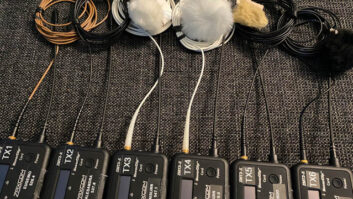A friend of mine who writes for one of the computer magazines, and who also happens to be a wonderful musician, gave me a shiver when he casually opened one recent column with, “When I trashed my wrists back in the ’80s…” I got another shiver when I received this reply to an e-mail I had sent to another computer writer: “I am on a typing break right now to rest my wrists, and cannot respond to any e-mail messages. I hope to return to my computer in about two weeks.” Yet another friend, also a very talented writer and musician, had to give up both careers when his wrists gave out after just a few months working as a tech support manager for a large company. Now he builds wooden boats and collects guitars, which he cannot play for more than a few minutes at a time. And just last month a student of mine showed up for his final exam with his arm in a brace so complicated that it looked like he must have fractured the limb in three places. “What happened?” I asked. “I’ve been working on my term project for my video course, and I’ve been editing at the computer for two days straight. I can’t feel my fingers.”
Musicians’ injuries are a well-discussed topic, and most of us are aware of the dangers of gigging and/or practicing too many hours for too many years. Two published surveys of working musicians back in the ’80s concluded that about 50% of them had some kind of job-related pain, but an occupational therapist I know puts the number today closer to 75%. Composer and pianist Robert Schumann complained of overuse injuries more than 150 years ago. More recently, injuries derailed the careers of pianists Gary Graffman and Leon Fleisher. Max Weinberg, drummer for the E Street Band and bandleader on Conan o’Brien’s TV show, once used to freeze his hands and tape his sticks to them to overcome the pain from tendinitis, just so he could get through a set. Now he says he’s fine, and he continues to play five nights a week-but he’s had no fewer than seven operations on his wrists and arms.
In the recording and live sound fields, when it comes to occupational hazards, the most popular topic among both engineers and performers has long been hearing loss. There is not a shred of doubt that exposure to high-decibel sound day after day leads to auditory degradation. Pete Townshend is the poster boy for what happens when you play too loud for too long-he surrounds himself with a plastic shell now whenever he’s on stage. Thanks to groups like the House Ear Institute and oSHA, a lot of progress has been made, and awareness of the dangers is at an all-time high, as are sales of earplugs and in-ear monitors. Even classical musicians have raised their consciousness about the dangers of loud sound-symphony orchestras now routinely place transparent baffles behind the last rows of the string section, to protect the players from the brass and percussion behind them.
Most of us who have worked long hours in the studio know about back and shoulder problems caused by sitting in the same spot while concentrating hard on the task at hand, paying no attention to those annoying little pains. Anyone who’s felt that pain linger for more than a couple of days has gone out and invested in an ergonomic chair. We are also now paying more attention to those who insist we get out of the chair (no matter how good it is) and stretch periodically. Good console ergonomics can also contribute to back and shoulder health, and most console manufacturers take into account the amount and frequency of awkward stretches users might have to endure when they design their control surfaces (although now, with the trend toward small-format, multifunction digital consoles, this is becoming less of an issue).
In the business world, however, there has been an alarming increase since the mid-’80s in repetitive strain injuries (RSI) and cumulative trauma disorders (CTD) caused by the huge increase in desktop computers in the workplace. Although it’s true that the computer revolution has meant that fewer American workers are losing fingers in threshing machines or breathing asbestos fibers or coal dust, workplace RSI has reached epidemic proportions: According to CNN, in one recent year 60% of workplace-related injuries or illnesses were RSI-related, costing the economy on the order of $120 billion in down time, lost productivity and workers’ compensation claims.
We in the audio business are not immune. Today, we are all computer workers, subject to the same ergonomic dangers as the drones at temp agencies and telemarketing companies. And the number of wrist and arm injuries from overuse among the professional audio and production community seems to be rising at an alarming rate.
“But I’m not an office slave,” you insist. “I don’t have to sit at a desk doing a boring job every day. I work for a great company doing cool things/I’m my own boss/I work out of my home/I can set my own schedule.” Don’t kid yourself. Any of these situations can actually make things worse. Large corporations are forced to pay attention to these issues, thanks to oSHA (and let’s face it, the recent brouhaha about oSHA “invading” the home office was really just a smokescreen set up by big companies who despise any kind of government oversight), the threat of lawsuits and workers’ comp claims, and those pesky unions who insist on a safe working environment. (Great bumpersticker I spotted recently: “Unions: The people who brought you the weekend!”) But workers in most studios, especially small and home-based ones, don’t have these kinds of protections.
If you’re trying to grow your business, and you’re the only one responsible for scheduling, updating the Web site, designing the brochure, writing contracts and finishing that mix by deadline, the chances are high that you will spend far too many hours than are good for you locked in front of your computer screen, manipulating words, numbers, slider-like objects and pictures of waveforms with a mouse. Although it’s not easy to pull yourself away from an intense work session, if you value your health, you’ll learn how to do just that.
I’ve suffered from wrist/arm problems myself, but I’m one of the lucky ones. Some years ago, I jammed my right wrist sliding into third base in a hot and heavy softball game (I swear to this day that I was safe), and it swelled up like a balloon. Two weeks later, the swelling had gone down, but it still hurt like hell. I saw a doctor who gave me some anti-inflammatory drugs, which seemed to do the trick, but a couple of months after that I started working on the score for an hour-long TV documentary (this was back in the days when MIDI-generated scores were still a rarity), and after a week of ten-hour days playing my keyboards and manipulating my mouse, the pain in my wrist was back.
This time, the doctor wanted to operate. He didn’t know what he was looking for-maybe a tear in the cartilage-so he told me it would be an “exploratory arthroscopy.” The idea of someone poking around inside my dominant hand with a plastic tube appealed to me not at all, and so I declined his offer and instead went to see an occupational therapist. She made me a custom wrist brace and gave me an ice pack, a squeeze ball to play with in free moments, and really good advice on how to take care of my hands. I still don’t know exactly what is wrong with my wrist (the consensus is that I have a form of tendinitis), but I have managed to avoid significant problems. When I play tennis, ride a bike, or mow the lawn, I wear a simple Velcro strap that keeps my wrist from turning in certain directions. When I have serious pain, which happens once or twice a year, I take a lot of ibuprofen and immobilize my wrist for a few hours with the fancy brace. And when I feel the first pangs of discomfort after hours of typing or mousing around, I stop and do something else for a while.
There are actually a number of different types of hand and wrist injuries caused by overuse and repetitive tasks. Probably the best known (and scariest) is Carpal Tunnel Syndrome. This is common among pianists and typists, and it’s what destroyed Leon Fleisher’s career. The nerves that run through your wrist go through a relatively small conduit between some fibrous tissue and the wrist bone, called the Carpal Tunnel. If any of the tissues around the tunnel get swollen or change position, the result is a pinched median nerve-the nerve that controls the thumb and first two fingers. You feel tingling, burning, cramping, numbness or “pins and needles” as if your hand has fallen asleep. In severe cases (like Fleisher’s) surgery is necessary to remove some of the tissue pinching the nerve. Needless to say, it’s very delicate surgery.
A related syndrome is Ulna Tunnel Syndrome-the ulnar is the elbow, and the affected area is the “funnybone” nerve. This is often caused by over-reliance of armrests on office chairs; ironically, the armrests are supposed to relieve strain on the wrist and forearm, but actually they end up pinching the ulnar nerve.
A more common problem-since it has a wide variety of causes-is tendinitis. In tendinitis, one or more tendons-the cords that attach the muscles to the bones-get inflamed and cause pain, usually a dull ache over the wrist and forearm. This is a common problem among guitar players, drummers and tennis players (most cases of “tennis elbow” are tendinitis), and it’s what Max Weinberg and I have in common.
Tenosynovitis is similar to tendinitis, but the inflammation is in the sheath surrounding the tendon, which lubricates it and keeps it moving smoothly. other RSIs include adverse mechanical tension, or neural tension, which can be a reaction to muscle spasms in the shoulders where the pain travels down the arm, and Thoracic outlet Syndrome, which is a compression of the nerves in the neck and shoulder. (It’s what happens if you hold the phone there too long; it can also affect the arm.) There’s also Myofascial Pain Syndrome, in which compression of the muscle tissue causes it to stiffen, creating painful “trigger points” that can move around and be very debilitating.
So what can you do to prevent and/or treat any of these conditions? I’m not a physician, and I’ve never even played one on TV, so I can’t give you medical advice, but what I can do is relay some of the guidance that I’ve received on these issues and point you to various resources that might help you. Next month, I’ll list a bunch of Web sites that provide information and advice on RSIs-if you can’t wait, I’ll be posting that list this month to Mixonline.com (click on “Insider Audio” from the front page). In the meantime, perhaps the best principle to follow if your hands, wrists, arms or back hurt during a heavy editing or mixing session is to stop what you’re doing and take a break. “No pain, no gain” may sometimes work for bodybuilders and linebackers, but for the rest of us, it’s really lousy advice. Better to paraphrase the old hippie motto: “If it feels bad, don’t do it.”







